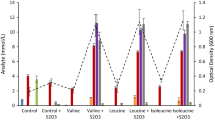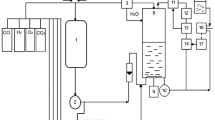Summary
Copolyesters of 3-hydroxybutyrate (3HB) and 3-hydroxyvalerate (3HV) have been produced by Alcaligenes eutrophus in nitrogenfree culture solutions of butyric and pentanoic acids. When pentanoic acid was used as the sole carbon source, a copolyester with an unusually high 3HV fraction of 90 mol% was produced. Copolyesters with a wide range of compositions (0–90 mol% 3HV) were obtained by using butyric and pentanoic acids together as carbon sources. The biosynthetic pathways of poly(3-hydroxybutyrate) were investigated using [1-13C]acetate and [1-13C]butyrate. It is suggested that butyric and pentanoic acids are incorporated into the copolyester as 3HB and 3HV units respectively without decomposition of the carbon skeletons in the cell.
Similar content being viewed by others
References
Bloembergen S, Holden DA, Hamer GK, Bluhm TL, Marchessault RH (1986) Studies of composition and crystallinity of bacterial poly(β-hydroxybutyrate-co-β-hydroxyvalerate). Macromolecules 19:2865–2871
Bluhm TL, Hamer GK, Marchessault RH, Fyfe CA, Veregin RP (1986) Isodimorphism in bacterial poly(β-hydroxybutyrate-co-β-hydroxyvalerate). Macromolecules 19:2871–2876
Doi Y, Kunioka M, Nakamura Y, Soga K (1986a) Nuclear magnetic resonance studies on poly(β-hydroxybutyrate) and a copolyester of β-hydroxybutyrate and β-hydroxyvalerate isolated from Alcaligenes eutrophus H16. Macromolecules 19:2860–2864
Doi Y, Kunioka M, Nakamura Y, Soga K (1986b) Biosynthesis of polyesters by Alcaligenes eutrophus: incorporation of 13C-labelled acetate and propionate. J Chem Soc Chem Commun 1696–1697
Doi Y, Kunioka M, Nakamura Y, Soga K (1987) Biosynthesis of copolyesters in Alcaligenes eutrophus H16 from 13C-labelled acetate and propionate. Macromolecules 20:2988–2991
Heinzle E, Lafferty RM (1980) A kinetic model for growth and synthesis of poly-β-hydroxybutyric acid (PHB) in Alcaligenes eutrophus H16. Eur J Appl Microbiol Biotechnol 11:8–16
Holmes PA (1985) Applications of PHB: a microbially produced biodegradable thermoplastic. Phys Technol 16:32–36
Oeding V, Schlegel HG (1973) β-Ketothiolase from Hydrogenomonas eutropha H16 and its significance in the regulation of poly-β-hydroxybutyrate metabolism. Biochem J 134:239–248
Owen AJ (1985) Some dynamic mechanical properties of microbially produced poly-β-hydroxybutyrate/β-hydroxyvalerate copolymers. Colloid Polymer Sci 263:799–803
Repaske R, Repaske AC (1976) Quantitative requirements for exponential growth of Alcaligenes eutrophus. Appl Environ Microbiol 32:585–591
Senior PJ, Dawes EA (1973) The regulation of poly-β-hydroxybutyrate metabolism in Azotobacter beijerinckii. Biochem J 134:225–238
Suzuki T, Yamane T, Shimizu S (1986) Kinetics and effect of nitrogen source feeding on production of poly-β-hydroxybutyric acid by fed-batch culture. Appl Microbiol Biotechnol 24:366–369
Author information
Authors and Affiliations
Rights and permissions
About this article
Cite this article
Doi, Y., Tamaki, A., Kunioka, M. et al. Production of copolyesters of 3-hydroxybutyrate and 3-hydroxyvalerate by Alcaligenes eutrophus from butyric and pentanoic acids. Appl Microbiol Biotechnol 28, 330–334 (1988). https://doi.org/10.1007/BF00268190
Received:
Accepted:
Issue Date:
DOI: https://doi.org/10.1007/BF00268190




